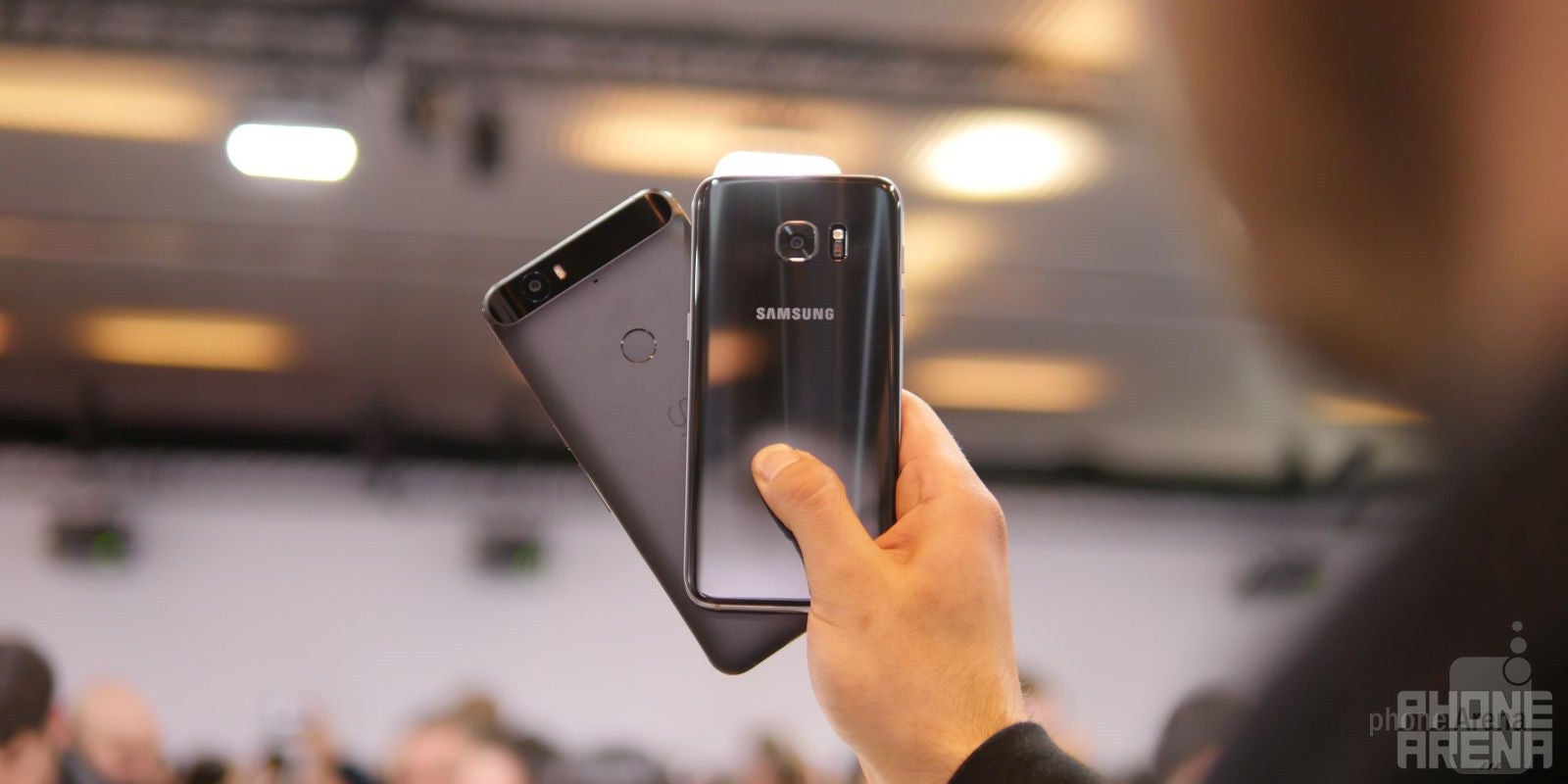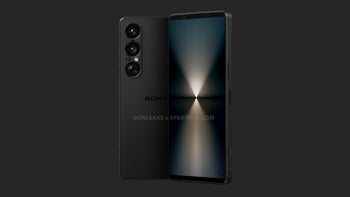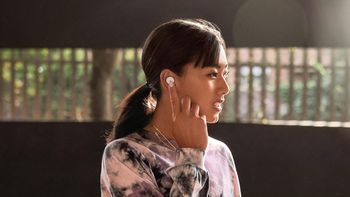Samsung Galaxy S7 edge vs Google Nexus 6P: first look

All of the data that we have right now points out that the Galaxy S7 edge can easily become the undisputed champion on the Android scene. Indeed, starting with the design of the phone and moving on to the specs, there's hardly any area where the S7 edge doesn't check just the right boxes. Still, we can't say that the S7 edge will have an easy job overpowering all there is - lots of formidable rivals out in the wild, folks, lots of them! Among these, chief stands the Google Nexus 6P, which is undoubtedly the best stock Android warrior right now. How do these stack up against one another?
Design
Intertwining metal, glass, and curved display up front, the Galaxy S7 edge is a gorgeous phone to loo look at. Truly, it is not a far cry from the rest of Samsung's handset that don "edge" in their names, but this is actually a good thing. We liked the S6 edge, we liked the S6 edge+, and it's no surprise that we liked the brand-new S7 edge as well. The design of the edgy new Samsung does not feel stale by any means, on the contrary - it feels perfected in all areas.
The Nexus 6P might not be as flashy as the Galaxy S7, but it also has its stand-out design features. For one, its rear houses a glossy black module at the top, which is refreshing design trait. That said, the rear of the Nexus 6P is not as uniform and sleek as the glass one of the S7 edge.
Size-wise, the Samsung handset has the upper hand. It's not only more compact and pocketable, but it also flaunts a superior screen-to-body size ratio - 76.09% vs 71.60%. As these percentages might mean nada to you, let us only say that Samsung had done a spectacular job at engineering the S7 edge.
Lastly, the S7 edge does not feel as slippery as the Nexus 6P - glass might be a fingerprint magnet but at least it provides a bit more grip than the aluminum back of the Nexus 6P. It's also worth a mention that Samsung has made the S7 edge water-tight thanks to some clever engineering. Your phone won't get damaged even if you put it in up to 3 feet deep fresh water for as long as an hour.
Display
Two AMOLED displays with one and the same resolution tightly clench in a battle for superiority here, folks. While the Nexus 6P offers more real estate with its 5.7-inch screen, the Galaxy S7 packs a sharper display. Additionally, the latter features dual edges on the sides, which are there mostly for cosmetic purposes, but they also offer some added functionality thanks to the re-introduced edge panels. These allow you to access nifty shortcuts to your favorite contacts, apps, or tools.
As far as the displays themselves are concerned, we are looking at two stunning and gorgeous screens. It's hard to pick our favorite at first sight, though we have to acknowledge that the Galaxy S7 edge truly captivates with the "edgy" design of its front.
Moreso, the always-on feature of the new Samsung handset makes it stand out even when you're not actively using the phone. Don't think that we don't like the Nexus 6P, though - it's just as good, though not as eye-catching!
Interface and functionality
Despite that these two are running Android 6.0 Marshmallow, they offer two pretty different approaches to the way users experience Google's OS.The Nexus 6P, being a Nexus device, is the posterchild for the stock Android experience. We've got a stock UI with stock features, and while this is not bad per say, it's a tad less exciting than having a more feature-rich skin. True, some people swear by vanilla Android and we understand them perfectly, but in this specific scenario, the S7 edge is undoubtedly more interesting.
Samsung’s TouchWiz UI has seen its up and downs, with last year’s iteration leaning towards the up direction with its refined, simpler approach. That’s yet again the trend with this latest edition running in the Galaxy S7 edge. The experience as a whole is identical to its sibling in the Galaxy S7, but with one major difference – the edge UX. As we said in the display section, these allow you to access various predefined features, contacts, tools, and multitask without leaving the app you're using.
Both the Nexus 6P and S7 edge have touch-based fingerprint scanners, and we're pretty hype to check out which one does its job faster with a smaller margin for error!
Performance and memory
Samsung made it clear during our meeting that two chipsets will be leveraged for the latest Galaxy S7 line, Qualcomm’s Snapdragon 820 chip for the US market, and its own Exynos for just about everywhere else. Both of these have 4GB of RAM in tow. The models we managed to check out delivered the swiftness and finesse that we come to expect in a high-end smartphone in this day and age. Naturally, the easy stuff is handled with ease, but Sammy also claims that the graphics processing of the handset isn’t going to be compromised because there’s Vulkan API access for gaming – as well as recording gaming footage in real-time.
Meanwhile, the Nexus 6P relies on the older, yet still top-end Snapdragon 810 chip, which is paired with 3GB of RAM for good measure. The proven Adreno 430 GPU will, naturally, take care of any graphics-oriented tasks you may throw at it. And in reality There are be a few different non-expandable storage options available: 32GB, 64GB, and 128GB – a choice that sounds reasonable enough.
Camera
For the Galaxy S7 edge, Samsung has opted to go with a 12-megapixel rear camera, which is accompanied with notable features such as an f/1.7 aperture lens and a brand new. Combining those elements with a “Dual Pixel” sensor and 1.4 µm sized pixels, Samsung claims that its low lighting performance and focus are going to be class-leading in the space. Indeed, the camera of the S7 edge does not only fire up in an instant, but it certainly sucks in way more light than most of the contemporary flagships.
In the Nexus camp, cameras have never been the focus of the stock Android troopers, but this got changed with 2015's 6P and 5X. With such a pronounced bump on the back of the Nexus 6P, Huawei has put in place all the ingredients of a competent camera. The 13-megapixel unit is aided by a laser-assist auto-focus, and dual-LED flash. On the front is an 8-megapixel sensor for sharp selfies and crisp video calling. Video recording up to 4K resolution is also part of the package. All-in-all, nothing new per se, but the camera has all the makings to be a fine picture taker.
Expectations
the Galaxy S7 edge is a no-compromise smartphone that’s an improvement over its predecessor. It’s not necessarily a giant leap forward, but rather, a tangible successor that addressed many of the missed opportunities. You know this will be one of the phones that’ll remain relevant throughout the year, and we can’t stress about the fact that it’s still one of the best looking – a testament indeed considering it now has a water-resistant construction.
The Nexus 6P is another no-compromise phone that will certainly be in the radars of those looking for a well-built, large-display phone that is a direct competitor to the S7 edge. Samsung went all out this year and the results are two flawless (at first sight) phones that certainly raise the bar, a bar that everyone will have to measure up to, the Nexus 6P included.













Things that are NOT allowed: